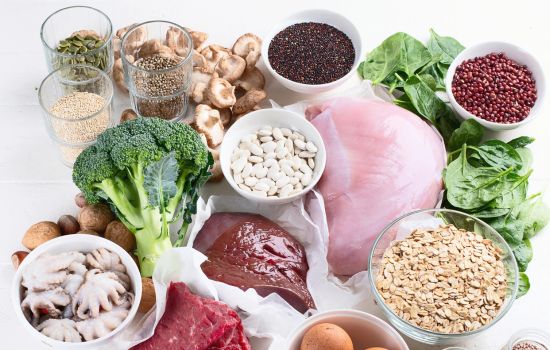A serious health problem that can affect a child’s growth and general well-being is iron deficiency. For the purpose of early detection and therapy, it is essential to comprehend the signs and causes of iron deficiency.
Table of Contents
Children’s Iron Deficiency Symptoms
1. Weakness and Fatigue
Children who are iron deficient frequently experience weakness and exhaustion. Hemoglobin, the part of red blood cells that carries oxygen, is made possible only by iron. Reduced oxygen supply to tissues due to low hemoglobin levels results in chronic fatigue and low energy.
2. Mucous membranes and pale skin
Pallor, or mucous membrane and skin paleness, is a prominent indicator of iron deficiency anemia. This happens as a result of fewer red blood cells, which reduces the amount of oxygen that reaches the skin and makes it appear pale.
3. Delayed Development and Growth
Growth and the development of cognition depend on iron. Children who are iron deficient may grow more slowly and face delays in their development. Cognitive deficits, delayed motor skill development, and slower physical growth are among manifestations of this.
4. Behavioral Issues
Iron deficiency is frequently linked to behavioral problems such as impatience, inattentiveness, and difficulties concentrating. Neurotransmitters are essential for healthy brain function and are produced in part by iron. Mood swings and behavioral abnormalities may result from low iron levels.

5. Repeated Infections
Children are more vulnerable to infections due to weakened immune systems caused by iron deficiency. An iron deficit can impair the body’s defenses against infections since iron is essential for immune cells to operate properly.
6. An Odd Predilection (Pica)
A hunger for non-food items such as ice, clay, or dirt, known as pica, may indicate an iron deficit. It is believed that this habit is related to the body’s attempt to get iron or other nutrients it needs from unorthodox sources.
7. Breathlessness
Children with iron deficiency anemia may have dyspnea due to the blood’s decreased ability to carry oxygen, particularly when they are physically active. This ailment arises from the body’s inability to provide the muscles with enough oxygen.
8. Cold Feet and Hands
Cold extremities are common in children with iron insufficiency. This is because the body prioritizes blood supply to important organs over the extremities, resulting in inadequate blood circulation.
Reasons Why Children Deficiency in Iron
1. Inadequate Consumption of Food
A major contributing factor to iron deficiency is inadequate food consumption. Foods high in iron include red meat, chicken, fish, lentils, beans, and cereals enriched with iron. Youngsters who follow restrictive diets or don’t eat enough of these foods run the danger of being iron deficient.
2. Inadequate Iron Absorption
A youngster may not become iron deficient even if their diet includes enough of it because of problems with absorption. IBD, celiac disease, and persistent diarrhea are among the illnesses that might hinder the intestines’ capacity to absorb iron from diet.
3. Higher Need for Iron
The need for iron increases with certain life stages or circumstances. More iron is needed during adolescent and infancy due to rapid growth. Furthermore, children going through a growth spurt and premature babies could require more iron.

4. Blood Loss
Iron reserves can be reduced by prolonged blood loss. This can be brought on by parasitic illnesses like hookworm, excessive menstruation in teenagers, or gastrointestinal hemorrhage. Over time, even small but frequent blood loss might exacerbate an iron deficit.
5. Persistent Diseases
Chronic diseases that affect the metabolism and usage of iron include cancer, autoimmune disorders, and chronic kidney disease. Chronic illness anemia is a situation in which the body has enough iron but is unable to use it effectively.
6. Breastfeeding Only Without Supplements
Even though breast milk is a wonderful source of iron, older infants may not get as much of it as they need. Unless the baby begins eating iron-rich complementary meals, exclusive nursing without iron supplementation may result in iron insufficiency after the baby’s iron stores diminish, approximately six months of age.
7. Cow’s Milk Was Introduced Early
When cow’s milk is introduced to a child before they turn one year old, iron insufficiency may result. Cow’s milk has low iron content, can obstruct the absorption of iron, and can induce microscopic hemorrhage in young infants’ intestines, which results in iron loss.
8. Vegetarian or Vegan Diets
Youngsters who consume only plant-based iron (non-heme iron) may be more susceptible to iron deficiency due to the inferior absorption of iron derived from animal sources (heme iron). To guarantee sufficient iron intake from plant-based sources, careful planning is required.

Preventive and Handling
1. Nutritional Approaches
Iron-rich, well-balanced diets are essential. Add foods high in iron, such as fish, eggs, beans, nuts, and fortified cereals, and lean meats. For vegetarians, non-heme iron absorption can be improved by combining meals high in vitamin C, such as citrus fruits, with foods high in iron.
2. Iron Addenda
If dietary changes are not enough, a doctor may recommend iron supplements. To prevent possible side effects like constipation and gastrointestinal pain, they should only be used under medical supervision.
3. Consistent Screening
Frequent iron deficiency screening can aid in early diagnosis and therapy, particularly in high-risk populations such as children with chronic illnesses, toddlers, and teenagers.
4. Awareness and Education
Early intervention can be facilitated by teaching parents and other caregivers about the significance of iron in the diet and how to identify symptoms of deficiency. Families might receive assistance in preventing iron deficiency through nutritional advice and awareness programs.
5. Controlling Contextual Factors
It is crucial to treat underlying medical problems that reduce iron absorption or raise iron requirements. This could entail taking care of adolescent girls’ irregular menstrual cycles, treating gastrointestinal ailments, or managing chronic illnesses.
Conclusions
Children’s iron insufficiency is a complex condition with a range of signs and causes. Early detection of the symptoms and comprehension of the underlying causes can result in efficient care and prevention.

